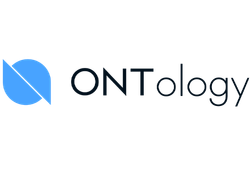
Free Airdrop Season 7 is LIVE! Answer fun questions or do simple tasks to earn rewards from the $30K BitDegree prize pool. Participate Now ! 🔥
You probably know all about the most popular cryptocurrencies, such as Bitcoin and Ethereum, however, there are newer, smaller projects like Ontology. If you want to find out more about the Ontology coin, you came to the right place.
In this complete Ontology coin guide, I am going to tell you everything you need to know about this cryptocurrency: ins and outs of the project, its pros and cons, and the team behind it.
First, I am going to give you an overview of how Ontology started and what its purpose is. After that, I am then going to explain how the technology works in a really simple way.
I am also going to cover things such as its real-world usage, as well as its security features and platforms where you can buy it (such as Binance). As always, keep your cryptocurrencies in secure wallets. If you don't know which one to choose, check out Ledger Nano X or Trezor Model T.
Let’s start by finding out what the Ontology token is!
Looking for the most secure place to buy BTC? I have collected the best-rated crypto exchanges that were approved as the safest platforms for buying BTC below, so take a look.
Pros
- Limitless potential
- Unique VBFT consensus model
- Great for businesses
Cons
- Strict country of origin
Table of Contents
Ontology Coin: What is Ontology?
Ontology is a high-performing, open-source blockchain that specializes in decentralized identity and data.
Ontology was established by Li Jun. It received technical support from a few members of Onchain's developer team during the platform's early development. However, don't get me wrong, these platforms are working as completely separate projects that have different goals.
Essentially, Ontology was created as a way for businesses of all sizes to install blockchain technology within their company, without having to completely change all of their current systems.
Even better, the team behind Ontology wanted to make it a really, really simple process, making it perfect for businesses that have no knowledge of blockchain technology.
One of the most interesting things about the start of the Ontology coin journey is that they did not hold an Ontology ICO. Instead, Ontology airdropped (transferred for free) their coins to a variety of people, including NEO coin holders and those who subscribed to the Ontology email newsletter! They also received funds from private investors.
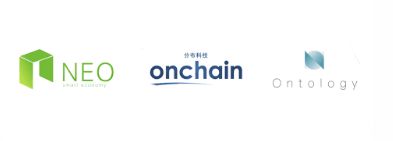
Note: An ICO stands for Initial Coin Offering and is a way for new crypto projects to raise funds. One of the largest ICO’s of all time was the EOS coin, which raised more than $4 billion!
What's important to note is that in June 2018, Ontology launched its own MainNet and it currently operates separately from the NEO blockchain.
So, now that you know how the project started, the next part of this Ontology coin guide will be focused on the utilization.
How Can Ontology Be Used?
Understanding just what the Ontology coin was created for can be quite a difficult task, so I thought it would be best to start with a real-world example. Think about your own medical records that are held at your local doctor’s surgery.
Every time you have an appointment, the doctor will make notes about your illness and recommendations (such as prescribed medication). Your notes will also contain information such as any allergies you have and any regular medication that you take.
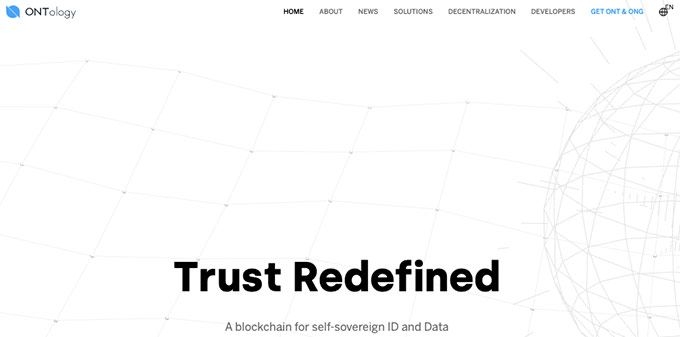
But what happens if you go to a doctor in a different city, hospital, or local pharmacy? These individual centers might not have access to your records without requesting permission from your doctor first. Why? Well, there are two main reasons.
Data protection laws do not allow your private information to be shared with anyone who asks for it. Secondly, each individual organization will have its own centralized systems, which makes it difficult to share information anyway.
However, this is where the Ontology project can solve these issues. Using the same example as above, your medical records could be placed on the Ontology network, which then connects them to other blockchain systems. Even though all of the organizations within the supply chain can be connected to the same blockchain, each of them can decide what information to share.
While all the hospitals in your home country might have complete access to your medical records, the pharmacy might only have access to basic information, such as your identity. In the blockchain industry, this is called “Permission Access”.
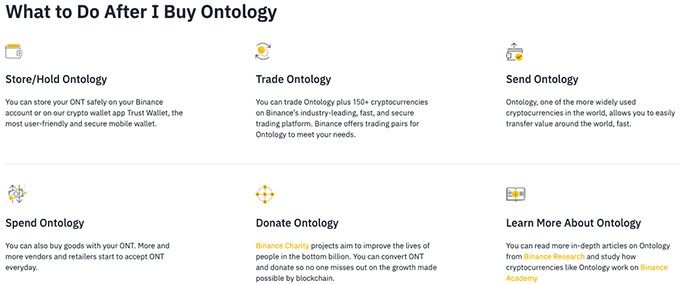
This is completely different from other blockchains such as Ethereum, as not only is information posted to the public ledger for all to see, but their blockchain is also open-sourced. Ultimately, this wouldn’t be ideal for businesses that need to keep certain information private. This is what Ontology was created for.
So now that you know the real-world purpose of the project, the next part of my guide is going to look at the Ontology token in more detail.

Did you know?
All Crypto Exchanges may look similar to you but they're NOT all the same!
The Ontology Coin in More Detail
To make things even more complicated for you, I have to tell you that Ontology will eventually have two different cryptocurrencies. The main coin is the Ontology coin that is called ONT for short.
The total amount of ONT is 1,000,000,000. However, almost 80% of them are currently in circulation.
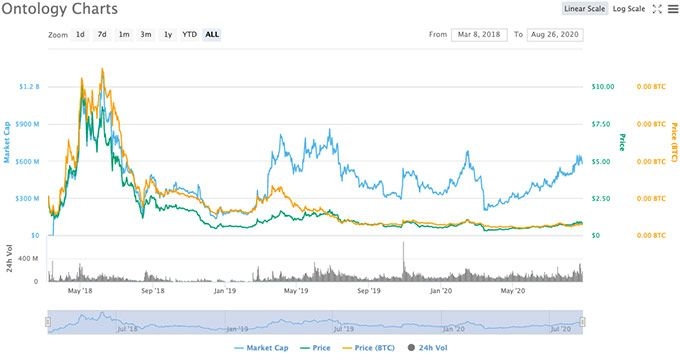
Source: coinmarketcap.com.
Back in June 2018, Ontology launched its MainNet. It followed the launch of Ontology 2.0 that was designed to support Layer 2 scalability and robust cross-chain collaboration. Two years later, in 2020, the new version of ONTO was launched. It's Ontology's data wallet that allows people to be in control of their own data.
How Do Transactions Work?
The purpose of the Ontology framework is that it is not intended to operate as a single blockchain. Instead, the technology will allow businesses to make full use of both private and public blockchain. Let me explain this in more detail.
A financial institution will not want to put all of their data on a public blockchain as it will allow their competitors to access all of their information. In this sense, they will install the Ontology blockchain, which is a private blockchain only accessible by the financial institution, or anyone else that they choose to share permission with.
However, there might be certain information that they do want to make public, such as the ability for people to verify their identity.
So, if a new customer wants to open an account with the financial institution and then they want to verify their identity, the public blockchain (such as NEO) can then communicate with the private blockchain (Ontology), which is where the private information is stored.
Therefore, Ontology acts as a bridge between the digital world and the real world, all in a trust-less environment. But how do you know that the information can be trusted? Well, like all other blockchains, the Ontology network uses a consensus mechanism.

A consensus mechanism is a way for blockchains to confirm and verify transactions without needing a third party. In other words, it’s what makes the blockchain decentralized. There are lots of different consensus mechanisms that are used by blockchains, with the most popular ones being Proof-of-Work and Proof-of-Stake.
However, the Ontology token is going to use something it calls VBFT, which combines three different models. These are Proof-of-Stake (PoS), Byzantine Fault Tolerant (BFT) and Verifiable Random Function (VRF).
To make things a bit clearer, let's compare what VBFT can do in comparison to other blockchains like Bitcoin and Ethereum. Both blockchains use the Proof-of-Work model, which in Bitcoin's case can verify up to 7 transactions per second and in Ethereum's, approximately 15.
Although still in its early days, it is expected that Ontology will be able to confirm thousands of transactions per second.
Note: Ethereum has plans to upgrade from Proof of Work to Proof of Stake, along with introducing other improvements to further resolve their scalability issues.
So what else is different? Well, the Proof-of-Work consensus model needs more than 50% of all nodes on the network to reach an agreement that the transaction is authentic. However, VBFT only needs 2/3, which allows for cheaper and faster transactions.
Don’t forget, the Ontology crypto network will not only be used for financial transactions but data of all types!
So now you know how the technology works, the next part of my Ontology coin guide is going to look at its potential.
Potential of Ontology?
In terms of real-world usage, the potential of the Ontology network is practically unlimited. This is because the blockchain protocol would benefit all business types – notably because it allows data to be transferred in a secure, transparent, fast and cheap manner. In general, Ontology offers businesses the flexibility to design a blockchain based on their personal wants and needs.
Not only this, but Ontology will also be able to provide a platform for dApp and smart contracts, which will be supported by the NEO blockchain. Essentially, this opens the doors up to complete automation, meaning that organizations can perform data transactions without needing a third party to verify it.
Remember how I explained earlier that the health care industry would benefit greatly from Ontology? Well, the smart contract feature would make things even more efficient. What if a doctor gave you a weekly prescription that was then posted to the Ontology network?
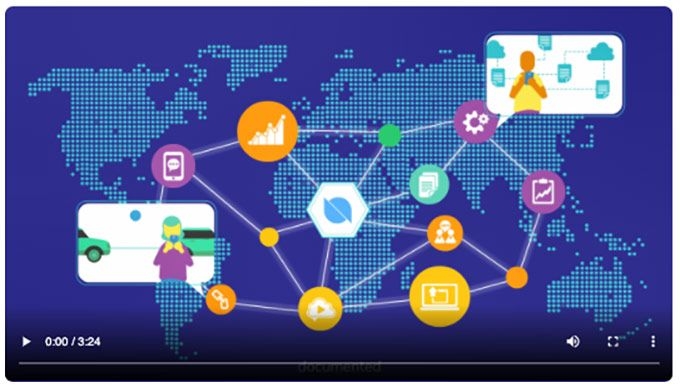
You could then take it to your local pharmacy and as soon as you collect it, the transaction would be posted to your medical file. Pretty cool, right?!
The value of the Ontology coin has grown extremely quickly since it was released. In fact, it has reached all-time highs of more than a billion dollars back in May 2018, making it one of the most popular cryptocurrency projects in the market. However, its potential to grow further will depend on what partnerships it makes.
In fact, one major partnership within China alone could see the price of the Ontology coin rocket!
On the other hand, Ontology operates in one of the strictest nations in the world when it comes to cryptocurrency – China. It is important to remember that the Chinese government has since put a stop to cryptocurrency trading and ICOs and are now even considering adding mining to that list.
If they feel that the Ontology blockchain does not match the ideology of the Chinese government, they could one day put a stop to it.
However, according to the Ontology Twitter page, OnChain was recently in meetings with representatives of the Chinese government, which is definitely a good sign!
So now that you know the potential of the ontology coin, the next part of my guide is going to look at how secure the network is.
Is Ontology Secure?
You should already have a pretty good understanding of what the Ontology project is, its purpose and how the technology works. However, security maintains the most crucial factor at all times.
If businesses are to install the Ontology network within their current systems, they need to guarantee that their private data won’t end up in the wrong hands.
Each and every data transaction is confirmed in a decentralized environment, meaning that no single person or authority can take control of the network.
As confirmation responsibilities are confirmed by the Ontology community (who hook up their device to the network), a hacker would need to take control of more than half of the devices on the network to have any effect whatsoever! Even then, it’d be so expensive for the hacker to execute their attack that it’d be rendered worthless.
This is much more secure than a regular, centralized system. As in a centralized system, a hack would be much cheaper and require much less effort than it would a decentralized system like the Ontology blockchain.
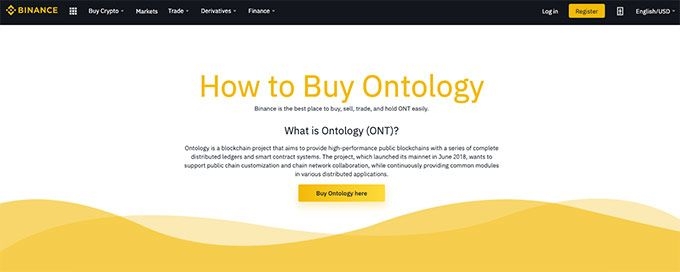
Buy Ontology on Binance
In a centralized system, there is a single point of entry for a hacker, while in a decentralized system, there are countless machines (typically spread out throughout the world) that need to be hacked.
To put this into perspective:
If you guessed the password to a computer that has access to a centralized server, you could then edit the documents on that server. However, if you do the same thing on a computer that runs a decentralized server, you won't be able to edit the documents. You’d need to control more than half of the entire network, not just one computer!
Furthermore, like all other blockchains, every single data transaction that occurs on the Ontology blockchain is immutable — they cannot be removed. This makes it extra secure as it adds a layer of transparency for the company that installs the protocol. Ultimately, the Ontology blockchain is very secure.
If you want to improve your security even more, choose secure hardware wallets to store your assets. The most recommended options include Ledger Nano X and Trezor Model T.
How Can it Be Abused?
As the ONT coin has been built from the bottom-up (meaning that it hasn’t been forked from another blockchain), the technology does not have any specific issues that would allow it to be abused. However, there are some important things to remember about cryptocurrencies in general.
When sending or receiving the Ontology crypto (or any other crypto), you do not need to reveal your real-world identity. Instead, the blockchain protocol allows you to send and receive coins anonymously. Although this has its advantages, it can also be abused by criminals who want to commit crimes anonymously.
One such example is the dark web, where websites sell illegal goods in return for cryptocurrencies. Another example is that cryptocurrencies could be ideal for people who want to launder money, as it is very difficult to find out who the real owner of the funds is.
However, these issues are not only associated with the ONT token.
Advantages and Disadvantages
Before concluding my Ontology coin guide, I thought it would be a good idea to summarize all of the advantages and disadvantages that I have covered!
Advantages:
- Simple entry for businesses: Ontology will be ideal for businesses of all sizes as no prior knowledge of blockchain technology is required.
- Great team: Ontology has a team of professionals that are working toward the same goal.
- Limitless potential: The number of industry sectors that would benefit from the Ontology coin is endless.
- Unique consensus: The VBFT consensus model used by Ontology is unique, combining both speed and safety. Transactions in the thousands per second are hoped to be possible.
- A bridge between real and virtual: The Ontology blockchain will allow the digital economy to connect with the real-world economy, across multiple blockchains.
Disadvantages:
- Strict country of origin: Ontology operates in one of the strictest nations for crypto regulation – China.

Did you know?
All Crypto Exchanges may look similar to you but they're NOT all the same!
Conclusion
That’s the end of my Ontology coin guide! Although understanding crypto can be challenging, in general, I hope I have cleared everything up for you regarding the Ontology project.
If you're interested in buying ONT, you should check out Binance - one of the most reliable cryptocurrency exchange platforms. You can also follow these simple steps to purchase and store your ONT coins securely:
1. Get Ledger Nano X or Trezor Model T.
2. Sign up to Binance.
3. Buy ONT coin from Binance.
4. Send your ONT coins to Ledger Nano X and Trezor Model T.
This is it. The process is really simple.
So, what do you think about the Ontology crypto project? Do you think it will be a success? I think that it has potential and can be ideal for small-to-medium businesses that do not have the expertise to implement their own blockchain.
What’re your thoughts after reading this guide? Let me know in the comments!
The content published on this website is not aimed to give any kind of financial, investment, trading, or any other form of advice. BitDegree.org does not endorse or suggest you to buy, sell or hold any kind of cryptocurrency. Before making financial investment decisions, do consult your financial advisor.













